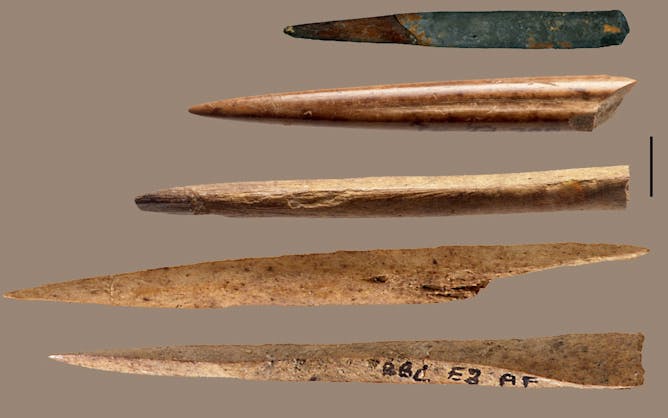|
Ethiopia’s Prime Minister Abiy Ahmed continues to push reforms that have garnered global praise. But, Yirga Gelaw Woldeyes argues, Abiy is ignoring an important group: the country's rural majority, who contribute significantly to the economy and must be included in the ongoing national conversation.
It's well established that our ancestors hunted, ate and worshiped many animals. Their bones were also used to create tools, like arrowheads. Justin Bradfield explains how a modern technique has uncovered fascinating details about which animals' bones were used for tools - and which were left alone, probably because of cultural taboos.
|

An Ethiopian farmer in the Amhara highlands outside the historic village of Lalibela.
EPA/Stephen Morrison
Yirga Gelaw Woldeyes, Curtin University
Despite all Ethiopia's Abiy Ahmed's inspirational reforms, there can be no progress without the rural majority.
|

Bone artefacts from various South African Stone Age archaeological sites have been interpreted as arrowheads.
J. Bradfield (as published in Bradfield, J. & Choyke, A. 2016. Bone technology in Africa. In: H. Selin (ed.), Encyclopaedia of the History of Science, Technology, and Medicine in Non-Western Cultures, pp, 20-27. Springer).
Justin Bradfield, University of Johannesburg
Species-level identification of bone tools has been undertaken for the first time in southern Africa.
|
Education
|
-
Sharon Fonn, University of the Witwatersrand
Working with African universities to effectively become research-intensive could transform sub-Saharan Africa's higher education landscape.
|
|
Environment + Energy
|
-
Gaathier Mahed, Nelson Mandela University
Groundwater is often seen as a resource that never runs out. This isn't true.
|
|
From our international editions
|
-
Stuart Gietel-Basten, Hong Kong University of Science and Technology
There are signs China could drop its two-child policy in an attempt to boost population growth.
-
Max Pensky, Binghamton University, State University of New York; Nadia Rubaii, Binghamton University, State University of New York
The evidence in the report is compelling, but experts explain there are many barriers to global leaders taking action.
-
Deirdre Clemente, University of Nevada, Las Vegas
On the front lines were female tennis players who refused to adhere to the club dress codes that banned them.
-
Lucy V Justice, Nottingham Trent University; Martin Conway, City, University of London; Shazia Akhtar, University of Bradford
A new study found that 14% of people report a memory from age one or below. They're likely fictitious.
|
|